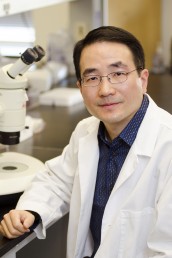Reactive oxygen species switch immune cells from migratory to murderous
Neutrophils are the superheroes of the body’s immune system. Normally mild-mannered, they travel through the bloodstream until they reach an emergency situation, such as a cut or infection, where they switch into battle-mode to engulf and destroy foreign invaders.
How do these microscopic avengers transition from silent, patrolling responders to merciless killing machines?
Researchers from the University of Illinois at Chicago, the National Institutes of Health and Fudan University in Shanghai have found that the key is a receptor molecule in the cell that senses reactive oxygen species. The finding is published in the journal Developmental Cell.
Reactive oxygen species, or ROS, are produced by the body as a byproduct of metabolism. They are harmful to cells at high levels, because they can bond to and damage molecules that the cell relies on, like DNA.
A receptor called TRPM2 acts as an ROS sensor or gauge inside the neutrophil. When ROS levels are low, the neutrophil is on the move, looking for infections to fight. As the neutrophil nears a wound site and begins to encounter foreign particles or bacteria, it engulfs them and generates a killing burst of ROS to destroy the captured enemy. TRPM2 senses these consistent, high levels of ROS inside the cell and puts the neutrophil in park, so the cell stays in place to continue killing invading microbes.
“The neutrophil senses a dramatic increase in reactive oxygen species as it gets closer to the wound site, and this triggers the shutdown of the migration of the cell,” said Jingsong Xu, assistant professor of pharmacology in the UIC College of Medicine and corresponding author on the paper.
“Once the neutrophil ceases moving, it just kills one bacteria or pathogen after another — and can concentrate on doing its job of cleaning up the site,” Xu said.
To shut down migration, TRPM2 must be chemically oxidized, which is what happens when it is exposed to reactive oxygen species. In its oxidized state, TRPM2 binds to another receptor called FPR1, which inactivates the signaling process that causes neutrophils to wander.
Drugs that target the TRMP2 receptor could be useful in preventing the migration of too many neutrophils to a wound site, Xu said.
“Too many neutrophils in a small area can actually damage tissue,” he said.
Co-authors on the study are Asrar Malik, Gang Wang, Luyang Cao, Xiaowen Liu, Nathan Sieracki, Anke Di, Shalina Taylor, Xiaojia Huang, Chinnaswarmy Tiruppathi, You-yang Zhao and Xiaopei Gao of the UIC College of Medicine; Xi Wen and Tian Jin of the National Institute of Allergy and Infectious Diseases; Yong Chen of the National Heart, Lung, and Blood Institute; and Yuanlin Song and Chunxue Bai of Fudan University.

